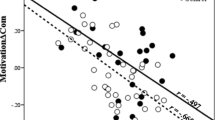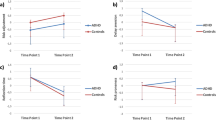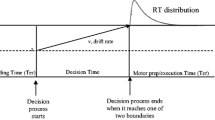Abstract
Greater sensitivity to the cost of effortful engagement has long been implicated in the development of Attention Deficit Hyperactivity Disorder (ADHD). The current study evaluated preferential choice to engage in demanding tasks, and did so in combination with computational methods to interrogate the process of choice. Children aged 8–12 with (n = 49) and without (n = 36) ADHD were administered the cognitive effort discounting paradigm (COG-ED, adapted from Westbrook et al., 2013). Diffusion modelling was subsequently applied to the choice data to allow for a better description of the process of affective decision making. All children showed evidence of effort discounting, but, contrary to theoretical expectations, there was no evidence that children with ADHD judged effortful tasks to be lower in subjective value, or that they maintained a bias towards less effortful tasks. However, children with ADHD developed a much less differentiated mental representation of demand than their non-ADHD counterparts even though familiarity with and exposure to the experience of effort was similar between groups. Thus, despite theoretical arguments to the contrary, and colloquial use of motivational constructs to explain ADHD-related behavior, our findings strongly argue against the presence of greater sensitivity to costs of effort or reduced sensitivity to rewards as an explanatory mechanism. Instead, there appears to be a more global weakness in the metacognitive monitoring of demand, which is a critical precursor for cost–benefit analyses that underlie decisions to engage cognitive control.


Similar content being viewed by others
Data Availability
Raw data pertaining to this study can be accessed via the Open Science Framework at https://osf.io/q3dnf/?view_only=070171da527843d6b2be80dc9f6fbcaa.
References
Addicott, M. A., Schechter, J. C., Sapyta, J. J., Selig, J. P., Kollins, S. H. & Weiss, M. D. (2019). Methylphenidate increases willingness to perform effort in adults with ADHD. Pharmacology, Biochemistry, and Behavior, 183, 14–21. https://doi.org/10.1016/j.pbb.2019.06.008
American Psychiatric Association. (2013). Diagnostic and statistical manual of mental disorders. (5th ed.).Washington, DC: Author.
Arnett, A. B., Rhoads, C. & Rutter, T. M. (2021). Reduced Error Recognition Explains Post-Error Slowing Differences among Children with Attention Deficit Hyperactivity Disorder. Journal of the International Neuropsychological Society, 1–11. https://doi.org/10.1017/S1355617721001065
Bakkour, A., Palombo, D. J., Zylberberg, A., Kang, Y. H., Reid, A., Verfaellie, M., Shadlen, M. N. & Shohamy, D. (2019). The hippocampus supports deliberation during value-based decisions. eLife, 8. https://doi.org/10.7554/eLife.46080
Balogh, L. & Czobor, P. (2016). Post-Error Slowing in Patients With ADHD: A Meta-Analysis. Journal of Attention Disorders, 20(12), 1004–1016. https://doi.org/10.1177/1087054714528043
Barkley, R. A. (1987). Defiant children. Guilford press.
Barkley, R. A. (1997). Behavioral inhibition, sustained attention, and executive functions: Constructing a unifying theory of ADHD. Psychological Bulletin, 121(1), 65–94. https://doi.org/10.1037/0033-2909.121.1.65
Cacioppo, J. T., Petty, R. E. & Kao, C. F. (1984). The efficient assessment of need for cognition. Journal of Personality Assessment, 48(3), 306–307. https://doi.org/10.1207/s15327752jpa4803_13
Coelho, G. L. D., Hanel, P. H. P. & Wolf, L. J. (2020). The Very Efficient Assessment of Need for Cognition: Developing a Six-Item Version*. Assessment, 27(8), 1870–1885. https://doi.org/10.1177/1073191118793208
Conners, C. K. (2008). Conners third edition (Conners 3). Los Angeles, CA: Western Psychological Services.
Culbreth, A. J., Westbrook, A., Braver, T. S. & Barch, D. M. (2020). Effort in Daily Life: Relationships Between Experimental Tasks and Daily Experience. Motivation Science, 6(3), 303–308. https://doi.org/10.1037/mot0000159
De Martino, B., Fleming, S. M., Garrett, N. & Dolan, R. J. (2013). Confidence in value-based choice. Nature Neuroscience, 16(1), 105–110. http://doi.org/https://doi.org/10.1038/nn.3279
Dunn, T. L., Lutes, D. J. C. & Risko, E. F. (2016). Metacognitive evaluation in the avoidance of demand. Journal of Experimental Psychology. Human Perception and Performance, 42(9), 1372. https://doi.org/10.1037/xhp0000236
DuPaul, G., Power, T., Anastopoulos, A. & Reid, R. (1998). ADHD Rating Scale-IV: Checklists, norms, and clinical interpretation. New York: Guildford Press. https://doi.org/10.1037/t05638-000
Feldman, J. S. & Huang-Pollock, C. (2021a). Slow drift rate predicts ADHD symptomology over and above executive dysfunction. Child Neuropsychology, 27(6), 834–855. https://doi.org/10.1080/09297049.2021.1902490
Feldman, J. S. & Huang-Pollock, C. (2021b). A New Spin on Spatial Cognition in ADHD: A Diffusion Model Decomposition of Mental Rotation. Journal of the International Neuropsychological Society: JINS, 27(5), 472–483. https://doi.org/10.1017/S1355617720001198
Fischer, R., Dreisbach, G. & Goschke, T. (2008). Context-sensitive adjustments of cognitive control: conflict-adaptation effects are modulated by processing demands of the ongoing task. Journal of Experimental Psychology: Learning, Memory, and Cognition, 34(3). https://doi.org/10.1037/0278-7393.34.3.712
Frank, M. J., Gagne, C., Nyhus, E., Masters, S., Wiecki, T. V., Cavanagh, J. F. & Badre, D. (2015). fMRI and EEG predictors of dynamic decision parameters during human reinforcement learning. The Journal of Neuroscience: The Official Journal of the Society for
Frye, C. C., Galizio, A., Friedel, J. E., DeHart, W. B. & Odum, A. L. (2016). Measuring delay discounting in humans using an adjusting amount task. JoVE (Journal of Visualized Experiments), (107), e53584. https://doi.org/10.3791/53584
Haatveit, B. C., Sundet, K., Hugdahl, K., Ueland, T., Melle, I. & Andreassen, O. A. (2010). The validity of d prime as a working memory index: results from the “Bergen n-back task”. Journal of Clinical and Experimental Neuropsychology, 32(8), 871–880. https://doi.org/10.1080/13803391003596421
Haenlein, M. & Caul, W. F. (1987). Attention deficit disorder with hyperactivity: A specific hypothesis of reward dysfunction. Journal of the American Academy of Child & Adolescent Psychiatry, 26(3), 356–362. https://doi.org/10.1097/00004583-198705000-00014
Hancock, P. A. (2013). In search of vigilance: The problem of iatrogenically created psychological phenomena. American Psychologist, 68(2), 97–109. https://doi.org/10.1037/a0030214
Hinshaw, S. R. (2002). Is ADHD an impairing condition in childhood and adolescence? In P. S. Jensen (Ed.), Attention deficit hyperactivity disorder: State of the science-best practices , (pp. 5–21). Civic Research Institute, xxiii, I.
Huang-Pollock, C., Karalunas, S. L., Tam, H. & Moore, A. N. (2012). Evaluating vigilance deficits in ADHD: A meta-analysis of CPT performance. Journal of Abnormal Psychology, 121(2), 360–371. https://doi.org/10.1037/a0027205
Huang-Pollock, C. L., Maddox, W. T. & Tam, H. (2014). Rule-Based and Information-Integration Perceptual Category Learning in Children With Attention-Deficit/Hyperactivity Disorder. Neuropsychology, 28(4), 594–604. https://doi.org/10.1037/neu0000075
Huang-Pollock, C., Ratcliff, R., McKoon, G., Roule, A., Warner, T., Feldman, J. & Wise, S. (2020). A diffusion model analysis of sustained attention in children with attention deficit hyperactivity disorder. Neuropsychology, 34(6), 641–653. https://doi.org/10.1037/neu0000636
Huang-Pollock, C., Ratcliff, R., McKoon, G., Shapiro, Z., Weigard, A. & Galloway-Long, H. (2017). Using the Diffusion Model to Explain Cognitive Deficits in Attention Deficit Hyperactivity Disorder. Journal of Abnormal Child Psychology, 45(1), 57–68. https://doi.org/10.1007/s10802-016-0151-y
Kokis, J. V., MacPherson, R., Toplak, M. E., West, R. F. & Stanovich, K. E. (2002). Heuristic and analytic processing: Age trends and associations with cognitive ability and cognitive styles. Journal of Experimental Child Psychology, 83(1), 26–52. https://doi.org/10.1016/s0022-0965(02)00121-2
Kool, W., McGuire, J. T., Rosen, Z. B. & Botvinick, M. M. (2010). Decision making and the avoidance of cognitive demand. Journal of Experimental Psychology. General, 139(4), 665–682. https://doi.org/10.1037/a0020198
Kurzban, R., Duckworth, A., Kable, J. W. & Myers, J. (2013). An opportunity cost model of subjective effort and task performance. The Behavioral and Brain Sciences, 36(6), 661–679. https://doi.org/10.1017/S0140525X12003196
Lahey B. B., Applegate B., McBurnett K., Biederman J., Greenhill L., Hynd G. W., … Shaffer D. (1994). DSM-IV field trials for Attention-Deficit Hyperactivity Disorder in children and adolescents. American Journal of Psychiatry, 151(11), 1673–1685. https://doi.org/10.1176/ajp.151.11.1673
Lee, D. G. & Usher, M. (2021). Value certainty in drift-diffusion models of preferential choice. Psychological Review. https://doi.org/10.1037/rev0000329
Luman, M., Oosterlaan, J. & Sergeant, J. A. (2005). The impact of reinforcement contingencies on AD/HD: a review and theoretical appraisal. Clinical Psychology Review, 25(2), 183–213. https://doi.org/10.1016/j.cpr.2004.11.001
Luman, M., Tripp, G. & Scheres, A. (2010). Identifying the neurobiology of altered reinforcement sensitivity in ADHD: A review and research agenda. Neuroscience and Biobehavioral Reviews, 34(5), 744–754. https://doi.org/10.1016/j.neubiorev.2009.11.021
Malanchini, M., Engelhardt, L. E., Grotzinger, A. D., Harden, K. P. & Tucker-Drob, E. M. (2019). “Same But Different”: Associations Between Multiple Aspects of Self-Regulation, Cognition, and Academic Abilities. Journal of Personality and Social Psychology, 117(6), 1164–1188. https://doi.org/10.1037/pspp0000224
Marx, I., Hacker, T., Yu, X., Cortese, S. & Sonuga-Barke, E. (2021). ADHD and the Choice of Small Immediate Over Larger Delayed Rewards: A Comparative Meta-Analysis of Performance on Simple Choice-Delay and Temporal Discounting Paradigms. Journal of Attention Disorders, 25(2), 171–187. https://doi.org/10.1177/1087054718772138
Matzke, D. & Wagenmakers, E. J. (2009). Psychological interpretation of the ex-Gaussian and shifted Wald parameters: A diffusion model analysis. Psychonomic Bulletin & Review, 16, 798–817.
Mies, G. W., Ma, I., de Water, E., Buitelaar, J. K. & Scheres, A. (2018a). Waiting and working for rewards: Attention-Deficit/Hyperactivity Disorder is associated with steeper delay discounting linked to amygdala activation, but not with steeper effort discounting. Cortex; a Journal Devoted to the Study of the Nervous System and Behavior, 106, 164–173. https://doi.org/10.1016/j.cortex.2018.05.018
Mies, G. W., Moors, P., Sonuga-Barke, E. J., van der Oord, S., Wiersema, J. R., Scheres, A., Lemiere, J. & Danckaerts, M. (2018b). A Pilot Study of Behavioral, Physiological, and Subjective Responses to Varying Mental Effort Requirements in Attention-Deficit/Hyperactivity Disorder. Frontiers in Psychology, 9, 2769. https://doi.org/10.3389/fpsyg.2018.02769
Nelson, T. O. & Narens, L. (1990). Metamemory: A theoretical framework and new findings. In G. Bower (Ed.), The psychology of learning and motivation: Advances in research and theory, Vol.26 (pp. 125–173). New York, NY: Academic Press. https://doi.org/10.1016/S0079-7421(08)60053-5
Niebaum, J. & Munakata, Y. (2020). Deciding what to do: Developments in children’s spontaneous monitoring of cognitive demands. Child Development Perspectives, 14(4), 202–207. https://doi.org/10.1111/cdep.12383
O’Leary, A. P. & Sloutsky, V. M. (2017). Carving Metacognition at Its Joints: Protracted Development of Component Processes. Child Development, 88(3), 1015–1032. https://doi.org/10.1111/cdev.12644
Owens, J. S., Goldfine, M. E., Evangelista, N. M., Hoza, B. & Kaiser, N. M. (2007). A critical review of self-perceptions and the positive illusory bias in children with ADHD. Clinical Child and Family Psychology Review, 10(4), 335–351. https://doi.org/10.1007/s10567-007-0027-3
Patros, C. H. G., Alderson, R. M., Kasper, L. J., Tarle, S. J., Lea, S. E. & Hudec, K. L. (2016). Choice-impulsivity in children and adolescents with attention-deficit/hyperactivity disorder (ADHD): A meta-analytic review. Clinical Psychology Review, 43, 162–174. https://doi.org/10.1016/j.cpr.2015.11.001
Polanczyk, G., de Lima, M. S., Horta, B. L., Biederman, J. & Rohde, L. A. (2007). The worldwide prevalence of ADHD: a systematic review and metaregression analysis. The American Journal of Psychiatry, 164(6), 942–948. https://doi.org/10.1176/appi.ajp.164.6.942
Rights, J. D. & Cole, D. A. (2018). Effect size measures for multilevel models in clinical child and adolescent research: New R-squared methods and recommendations. Journal of Clinical Child & Adolescent Psychology, 47(6), 863–873.
Ratcliff, R. (1978). A theory of memory retrieval. Psychological Review, 85(2), 59.
Ratcliff, R. & Tuerlinckx, F. (2002). Estimating parameters of the diffusion model: Approaches to dealing with contaminant reaction times and parameter variability. Psychonomic bulletin & review, 9(3), 438–481. https://doi.org/10.3758/BF03196302
Ratcliff, R. & McKoon, G. (2008). The diffusion decision model: Theory and data for two-choice decision tasks. Neural Computation, 20(4), 873–922. https://doi.org/10.1162/neco.2008.12-06-420
Reynolds, C. R. & Kamphaus, R. W. (2004). Behavior assessment system for children (2nd ed.). Bloomington, MN: Pearson Assessments.
Reynolds, C. R. & Kamphaus, R. W. (2015). Behavior assessment system for children–Third Edition (BASC-3). Bloomington, MN: Pearson Assessments.
Salum, G. A., Sergeant, J., Sonuga-Barke, E., Vandekerckhove, J., Gadelha, A., Pan, P. M., ... Rohde, L. A. P. (2014). Specificity of basic information processing and inhibitory control in attention deficit hyperactivity disorder. Psychological Medicine, 44(3), 617–631. https://doi.org/10.1017/s0033291713000639
Sanders, A. F. (1983). Towards a model of stress and human performance. Acta Psychologica, 53(1), 61–97. https://doi.org/10.1016/0001-6918(83)90016-1
Sattler, J. (2008). Resource Guide to Accompany Assessment of Children: Cognitive Foundations, 5th Edition. San Diego: Jerome Sattler Publisher, Inc.
Sattler, J. (2018). Resource Guide to Accompany Assessment of Children: Cognitive Foundations and Applications, 6th Ed. La Mesa, California: Jerome Sattler Publisher, Inc.
Sergeant, J. A. (2000). The cognitive-energetic model: An empirical approach to Attention-Deficit Hyperactivity Disorder. Neuroscience and Biobehavioral Reviews, 24(1), 7–12.
Sergeant, J. A. (2005). Modeling attention-deficit/hyperactivity disorder: a critical appraisal of the cognitive-energetic model. Biological Psychiatry, 57(11), 1248–1255. https://doi.org/10.1016/j.biopsych.2004.09.010
Scherbaum, S., Fischer, R., Dshemuchadse, M. & Goschke, T. (2011). The dynamics of cognitive control: Evidence for within‐trial conflict adaptation from frequency‐tagged EEG. Psychophysiology, 48(5), 591–600. https://doi.org/10.1111/j.1469-8986.2010.01137.x
Scherbaum, S., Haber, P., Morley, K., Underhill, D. & Moustafa, A. A. (2018). Biased and less sensitive: A gamified approach to delay discounting in heroin addiction. Journal of Clinical and Experimental Neuropsychology, 40(2), 139–150. https://doi.org/10.1080/13803395.2017.1324022
Scime, M. & Norvilitis, J. M. (2006). Task performance and response to frustration in children with attention deficit hyperactivity disorder. Psychology in the Schools, 43(3), 377–386. https://doi.org/10.1002/pits.20151
Shaffer, D., Fisher, P. & Lucas, R. (1997). NIMH diagnostic interview schedule for children- IV. New York: Ruane Center for Early Diagnosis, Division of Child Psychiatry, Columbia University. https://doi.org/10.1097/00004583-200001000-00014
Shapiro, Z. R., Bray, B., & Huang-Pollock, C. (2023). Mechanism-based groups of children with ADHD are associated with distinct domains of impairment. Psychiatry Research, 319, 115018. https://doi.org/10.1016/j.psychres.2022.115018
Shenhav, A., Fahey, M. P. & Grahek, I. (2021). Decomposing the motivation to exert mental effort. Current Directions in Psychological Science, 30(4), 307–314. https://doi.org/10.1177/09637214211009510
Sonuga-Barke, E. J. S., Wiersema, J. R., van der Meere, J. J. & Roeyers, H. (2010). Context- dependent dynamic processes in attention deficit/hyperactivity disorder: differentiating common and unique effects of state regulation deficits and delay aversion. Neuropsychology Review, 20(1), 86–102. https://doi.org/10.1007/s11065-009-9115-0
Stewart, N. (2009). EPS Prize Lecture: Decision by sampling: The role of the decision environment in risky choice. The Quarterly Journal of Experimental Psychology, 62(6), 1041–1062.
Tran, T., Hagen, A. E., Hollenstein, T. & Bowie, C. R. (2021). Physical-and cognitive-effort- based decision-making in depression: Relationships to symptoms and functioning. Clinical Psychological Science, 9(1), 53–67.
Uchida, M., Spencer, T. J., Faraone, S. V. & Biederman, J. (2018). Adult outcome of ADHD: an overview of results from the MGH longitudinal family studies of pediatrically and psychiatrically referred youth with and without ADHD of both sexes. Journal of Attention Disorders, 22(6), 523–534.
Wechsler, D. (2003). Wechsler intelligence scale for children . San Antonio: PsychCorp.
Weigard, A. & Huang-Pollock, C. (2017). The Role of Speed in ADHD-Related Working Memory Deficits. Clinical Psychological Science, 5(2), 195–211. https://doi.org/10.1177/2167702616668320
Weigard, A., Huang-Pollock, C. & Brown, S. (2016). Evaluating the consequences of impaired monitoring of learned behavior in attention-deficit/hyperactivity disorder using a Bayesian hierarchical model of choice response time. Neuropsychology, 30(4), 502–515. https://doi.org/10.1037/neu0000257
Weigard, A., Huang-Pollock, C., Brown, S. & Heathcote, A. (2018). Testing formal predictions of neuroscientific theories of ADHD with a cognitive model-based approach. Journal of Abnormal Psychology, 127, 529–539. https://doi.org/10.1037/abn0000357
Weigard, A., McCurry, K., Shapiro, Z., Martz, M., Angstadt, M., Heitzeg, M. & Sripada, C. (2022). Generalizable prediction of childhood ADHD symptoms from neurocognitive testing and youth characteristics. https://doi.org/10.31234/osf.io/pjwmv
Westbrook, A., Kester, D. & Braver, T. S. (2013). What is the subjective cost of cognitive effort? Load, trait, and aging effects revealed by economic preference. PloS One, 8(7), e68210. https://doi.org/10.1371/journal.pone.0068210
Westbrook, A., Lamichhane, B. & Braver, T. (2019). The Subjective Value of Cognitive Effort is Encoded by a Domain-General Valuation Network. Journal of Neuroscience, 39(20), 3934–3947. https://doi.org/10.1523/JNEUROSCI.3071-18.2019
Westbrook, A., van den Bosch, R., Maatta, J. I., Hofmans, L., Papadopetraki, D., Cools, R. & Frank M . J. (2020) Dopamine promotes cognitive effort by biasing the benefits versus costs of cognitive work. Science, 367(6484), 1362-1366. https://doi.org/10.1126/science.aaz5891
Westbrook, A., Yang, X., Bylsma, L. M., Daches, S., George, C. J., Seidman, A. J., Jennings, J. R., & Kovacs, M. (2022). Economic choice and heart rate fractal scaling indicate that cognitive effort is reduced by depression and boosted by sad mood. Biological Psychiatry, Cognitive Neuroscience and Neuroimaging. https://doi.org/10.1016/j.bpsc.2022.07.008
Wiecki, T. V., Sofer, I. & Frank, M. J. (2013). HDDM: Hierarchical Bayesian estimation of the Drift-Diffusion Model in Python. Frontiers in Neuroinformatics, 7, 14. https://doi.org/10.3389/fninf.2013.00014
Winter, Y., Ben-Pazi, H. & Pollak, Y. (2019). Effort Allocation in Children With ADHD: Abnormal Decision-Making or Poor Execution? Journal of Attention Disorders, 23(11), 1240–1250. https://doi.org/10.1177/1087054716654569
Zajkowski, W., Bielecki, M. & Marszał-Wiśniewska, M. (2022). Are you confident enough to act? Individual differences in action control are associated with post-decisional metacognitive bias. PloS One, 17(6), e0268501. https://doi.org/10.1371/journal.pone.0268501
Acknowledgements
This work was supported in part by National Institute of Mental Health Grant R01 MH084947, as well as funding from the Social Science Research Institute (SSRI) at Penn State, to Cynthia Huang-Pollock. The content is solely the responsibility of the authors and does not necessarily represent the official views of the National Institutes of Mental Health.
Author information
Authors and Affiliations
Corresponding author
Ethics declarations
Conflict of Interest
The authors report no conflicts of interest.
Additional information
Publisher's Note
Springer Nature remains neutral with regard to jurisdictional claims in published maps and institutional affiliations.
Supplementary Information
Below is the link to the electronic supplementary material.
Rights and permissions
Springer Nature or its licensor (e.g. a society or other partner) holds exclusive rights to this article under a publishing agreement with the author(s) or other rightsholder(s); author self-archiving of the accepted manuscript version of this article is solely governed by the terms of such publishing agreement and applicable law.
About this article
Cite this article
Yan, X., Huang-Pollock, C. Preferential Choice to Exert Cognitive Effort in Children with ADHD: a Diffusion Modelling Account. Res Child Adolesc Psychopathol 51, 1497–1509 (2023). https://doi.org/10.1007/s10802-023-01080-x
Accepted:
Published:
Issue Date:
DOI: https://doi.org/10.1007/s10802-023-01080-x




